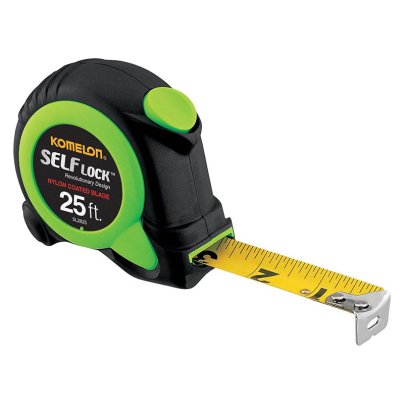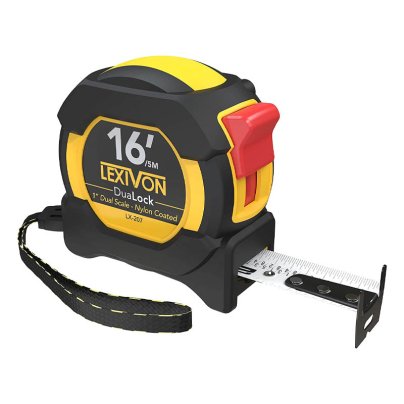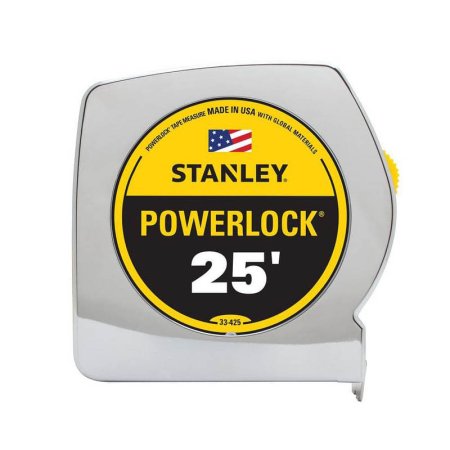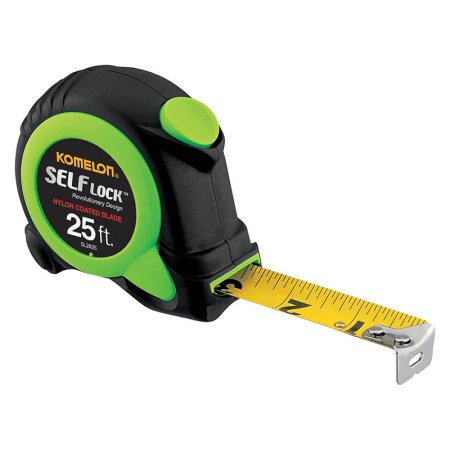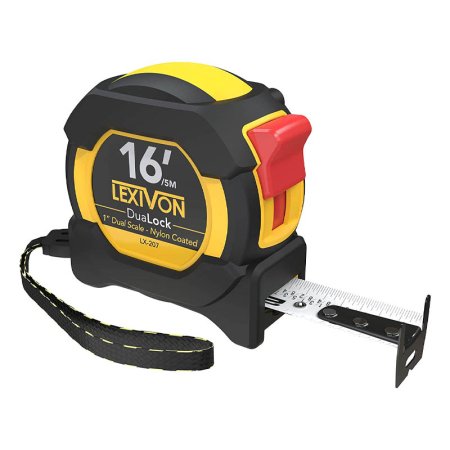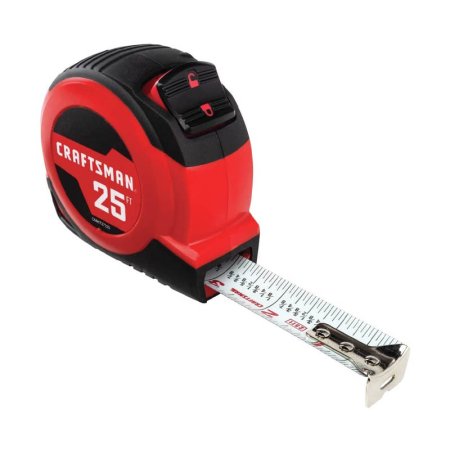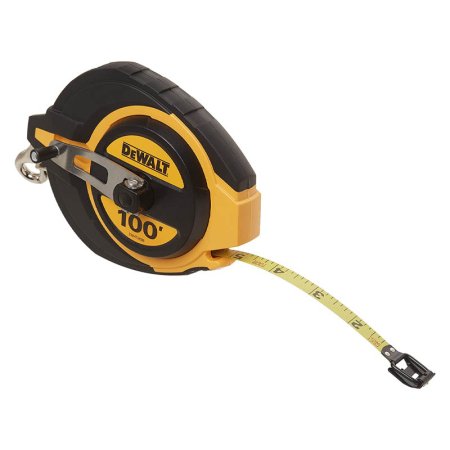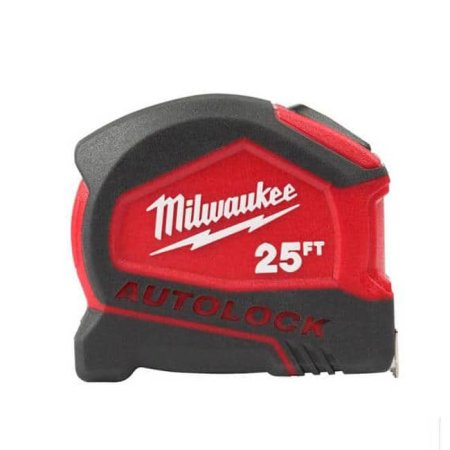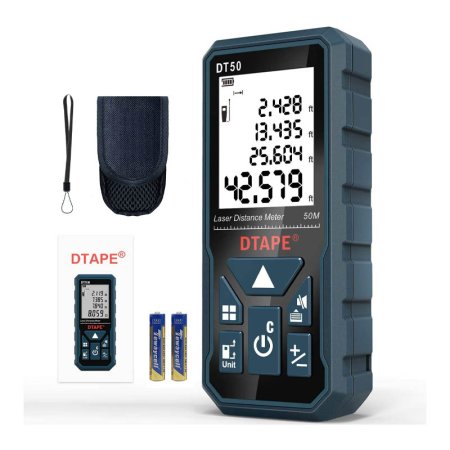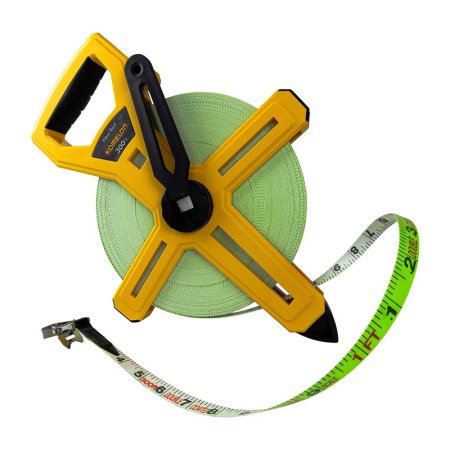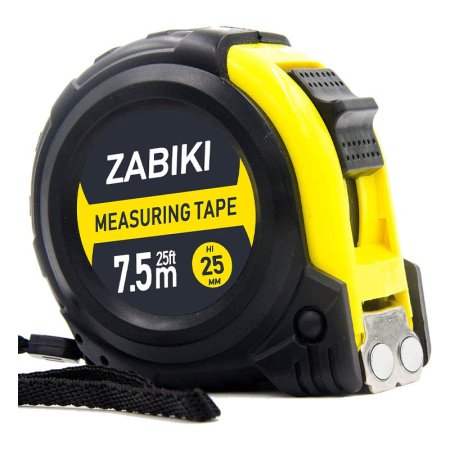
We may earn revenue from the products available on this page and participate in affiliate programs. Learn More ›
The adage “measure twice, cut once” is key in all kinds of craft and construction projects—and following it is much easier with a tape measure. However, since tape measures are readily available in various types and at a wide range of prices, it’s hard to know which ones are accurate and reliable. To help you choose a measuring tape you can trust, we put 10 top options to the test and reached out to an expert for their insights on the matter.
Based on our tests and our expert’s advice, we chose the Stanley 25-Foot PowerLock Tape Measure for its accuracy, durable construction, and reasonable price. We also found several other options that offer quality, precision, and the ability to withstand repetitive use. Read on for a breakdown of the best tape measures, their pros and cons, and things to consider when selecting the right tool for your needs.
- BEST OVERALL: Stanley 25-Foot PowerLock Tape Measure
↓ Jump to Review - BEST BANG FOR THE BUCK: Komelon Self-Lock 25-Foot Power Tape
↓ Jump to Review - BEST POCKET-SIZE: Lexivon 16Ft/5m DuaLock Tape Measure
↓ Jump to Review - BEST HEAVY-DUTY: Craftsman 25-Foot Self-Lock Tape Measure
↓ Jump to Review - BEST FOR LAYOUTS: DeWalt 100-Foot Closed-Case Long Tape
↓ Jump to Review - EASIEST TO READ: Milwaukee 25-Foot Compact Auto-Lock Tape Measure
↓ Jump to Review - BEST LASER MEASURE: DTape DT50 165-Foot Laser Measure
↓ Jump to Review - BEST FOR DISTANCES: Komelon 300-Foot Fiberglass Open-Reel Tape Measure
↓ Jump to Review - BEST METRIC: Zabiki 25-Foot Dual-Side Tape Measure
↓ Jump to Review
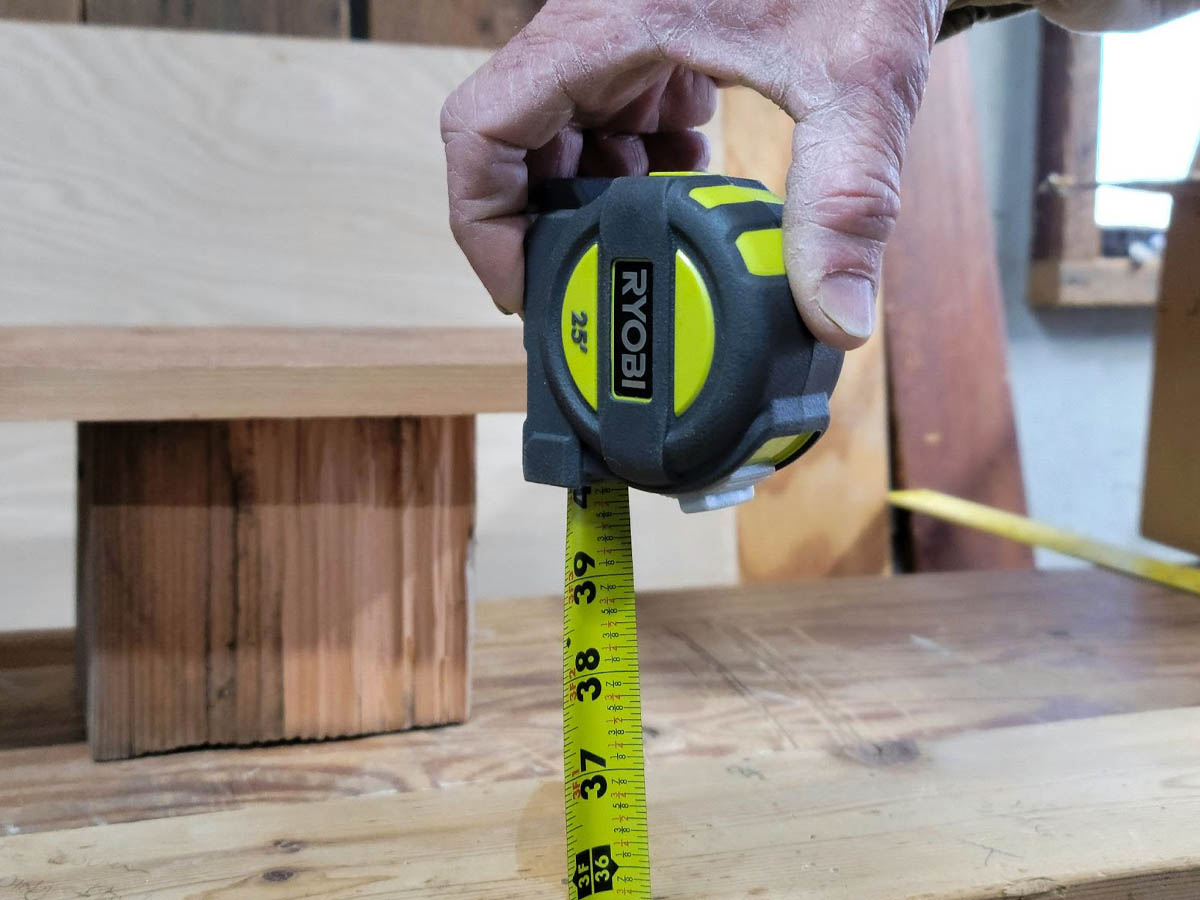
Tape Measure Comparison Chart
| Product Name | Type | Length | Markings |
| Stanley 25-Foot PowerLock Tape Measure | Cased | 25 feet | Imperial only |
| Komelon Self-Lock 25-Foot Power Tape | Cased | 25 feet | Imperial only |
| Lexivon 16Ft/5m DuaLock Tape Measure | Cased | 16 feet | Imperial and metric |
| Craftsman 25-Foot Self-Lock Tape Measure | Cased | 25 feet | Imperial only |
| DeWalt 100-Foot Closed-Case Long Tape | Reel | 100 feet | Imperial only |
| Milwaukee 25-Foot Compact Auto-Lock Tape Measure | Cased | 25 feet | Imperial only |
| DTape DT50 165-Foot Laser Measure | Laser | 165 feet | Digital, imperial and metric |
| Komelon 300-Foot Fiberglass Open-Reel Tape Measure | Reel | 300 feet | Imperial only |
| Zabiki 25-Foot Dual-Side Tape Measure | Cased | 25 feet | Imperial and metric |
Our Top Picks
To qualify for a spot in our lineup of the best tape measures, the following products had to meet our high testing standards. While any of them are worthy of a place in your home tool kit, we suggest you review each one to determine which is best for your needs.
Best Overall
Stanley 25-Foot PowerLock Tape Measure
What We Like
- Metal blade stays stiff during use
- Smooth retraction mechanism doesn’t catch
- High-quality construction at a great price
What We Don’t Like
- No metric measurements
Specs
- Type Cased
- Length 25 feet
- Markings Imperial only
From a name well known in the building industry comes the Stanley 25-foot PowerLock tape measure—a dependable and accurate choice for anyone needing to make precision cuts. It features a stainless steel case with a strong blade lock that holds firmly without slipping. In our tests, the durable metal extended to nearly 10 feet before bending, which is quite an accomplishment compared to thinner blades that bend at 5 feet or less.
The PowerLock has a 3-rivet-reinforced tang for accurate measuring and features imperial-only measurements in ⅙-inch increments. This labeled tape measure also has red premarked 16-inch notations for easy stud locating and black diamonds every 19.2 inches, which is another spacing interval often used in framing. After the first 12 inches, the Stanley tape shows both feet and inches as well as cumulative inch measurements (e.g., both 30 inches and 2 feet, 6 inches), which is useful when determining longer distances.
What our tester says: “This tape is highly accurate and durable, and since it has a clip for easy carrying on a pocket or belt, it’s a tape measure we find ourselves relying on time and time again.”—Glenda Taylor, Product Reviews tester and writer
Get the Stanley tape measure at Tractor Supply Co., Ace Hardware, or The Home Depot.
Best Bang for the Buck
Komelon Self-Lock 25-Foot Power Tape
What We Like
- Self-locking feature automatically secures blade
- Push-button blade retrieval eliminates fumbling
- Stainless steel clip grips tool belts tightly
What We Don’t Like
- Auto-lock function less effective at longer lengths
- No metric measurements
Specs
- Type Cased
- Length 25 feet
- Markings Imperial only
DIYers don’t need to overspend to get an accurate tape measure, and the Komelon self-lock power tape is a great budget-friendly option. The easy-read tape measure not only has precise markings, but they’re also on both edges, allowing for easy, accurate readings from either side. The Komelon also features graphic notations every 16 inches and 19.2 inches, making it well suited for standard framing measurement. It demonstrated rigid blade standout to just over 7 feet, making it a very decent tape measure for the price point.
Another standout feature of this Komelon is its self-lock mechanism, which automatically holds the blade in place when engaged, eliminating the need to manually engage a stiff blade lock. It has a bright green button that, when pressed, retracts the blade smoothly and doubles as a manual lock. While we loved using it to trigger a smooth retraction of the blade, we found we did have to use it to manually lock the blade at longer lengths. The auto lock worked when at distances of a few feet, but by the time we extended the blade to 20 feet, it started to slip. Still, the measurements are highly accurate, and we appreciate being able to use the green button to lock the blade manually.
Get the Komelon self-lock tape measure at Amazon, Lowe’s, Ace Hardware, or Walmart.
Best Pocket-Size
Lexivon 16-Foot/5-Meter DuaLock Tape Measure
What We Like
- Compact; great for shorter-length measurements
- Rubberized grip doesn’t slip
- Dual blade-locking system with pressure-sensitive button
What We Don’t Like
- Too short for larger jobs
Specs
- Type Cased
- Length 16 feet
- Markings Imperial and metric
TThose looking for a quality compact tape measure need look no further than the Lexivon 16-foot tape measure, which comes with both imperial and metric measurements and graphic markings denoting standard 16-inch and 19.2-inch framing measurements. It features a smooth rubberized overmold, a steel belt/pocket clip, and hook-under tang forks that allow the user to snag the upper or underside of the item being measured.
In our tests, we were able to extend it nearly 6 feet (standout) before it bent, we found the numbers easy to read, and we were impressed by the dual blade-locking system. In addition to a standard blade lock, it also has a pressure-sensitive button on the bottom of the case. Pressing the button stops the blade from moving, and letting up on it a bit allows it to retract slowly. Anyone undertaking a small job who’s been cut by a metal tape blade that retracted too quickly will appreciate the pocket-sized Lexivon.
Get the Lexivon tape measure at Amazon or Walmart.
Best Heavy-Duty
Craftsman 25-Foot Self-Lock Tape Measure
What We Like
- High-quality construction for heavy use
- Smaller fractions labeled for precise measurements
- Self-locking with smooth blade movement
What We Don’t Like
- No metric measurements
Specs
- Type Cased
- Length 25 feet
- Markings Imperial only
Everything about the Craftsman heavy-duty tape measure points toward it being a quality tool made to withstand high use. The case is made from heavy molded polyethylene and features a partial rubberized grip along the top and bottom edges. The belt clip is polished solid steel, and the metal blade is nylon coated for durability and rust resistance. The movement on the blade is smooth, and the retraction is controlled and even.
Although it only has imperial measurements (with standard graphic notations every 16 and 19.2 inches), it improves over some tapes in that incremental fractions are printed along the bottom edge of the blade. We checked the measurements on the Craftsman tape against our steel measure, and they were spot-on. This Craftmas also features a 3-rivet tang and a labeled lock button that doesn’t leave the user guessing which direction is locked and which is unlocked. The tape is self-locking as well, making it well suited to anyone who doesn’t want to take the extra time to set the lock manually.
Get the Craftsman tape measure at Amazon, Ace Hardware, or Walmart.
Best for Layouts
DeWalt 100-Foot Closed-Case Long Tape
What We Like
- Fast-winding crank retracts with minimal turning
- Coated for rust resistance
- Constructed to withstand tough jobsites
What We Don’t Like
- ⅜-inch wide tape slightly on the thin side
Specs
- Type Reel
- Length 100 feet
- Markings Imperial only
The DeWalt 100-foot tape measure is perfect for tasks like staking out an area for excavating or determining the dimensions of a lot. With imperial measurements at ⅛-inch increments, it’s not suited to making precise carpentry cuts, but it wasn’t designed for that. Instead, the 100-foot reel tape measure is made to obtain longer measurements, and it’s typically used outdoors when laying out foundations or determining the length of a proposed fence line.
The tang comes with a fold-out spike that is useful for fitting over a nail or screw head, and the molded plastic case is strong and durable with a partially rubberized grip. The flexible fiberglass blade has a rust-resistant coating that gives it stability, even in tough jobsite conditions like wind and rain. The stainless steel crank arm is snug without any play, and it features a 5-to-1 gear ratio, which allowed us to wind up the entire tape with just a dozen or so turns. The tape comes with an attached stainless steel carabiner clip that’s perfect for hanging on a hook.
What our tester says: “We’re familiar with reel tape measures and DeWalt products, so we had high hopes for this specific tool—and we weren’t disappointed. We were especially impressed when we hooked the tang on a nail, stretched the tape to its maximum length, and it didn’t flip this way and that in the wind like some reel tapes do.”—Glenda Taylor, Product Reviews tester and writer
Get the DeWalt tape measure at Amazon, Tractor Supply Co., Ace Hardware, or The Home Depot.
Easiest to Read
Milwaukee 25-Foot Compact Auto-Lock Tape Measure
What We Like
- Easy-read measuring tape with large numbers
- Self-locking mechanism and hook-under forks
- Partial rubberized case and belt/pocket clip
What We Don’t Like
- No metric measurements
Specs
- Type Cased
- Length 25 feet
- Markings Imperial only
Milwaukee is nationally known for high-quality construction tools and accessories, and the Milwaukee 25-foot self-lock tape measure is no exception. As with all the tapes we tested, the Milwaukee’s measurements were spot-on. The tape’s bold black whole-inch numbers are large and easy to read against the muted yellow background. In addition, the smaller fractions are clearly labeled along the bottom edge of the tape, with the ¼-inch fractions appearing in bold and the ⅛-inch fractions in regular type, making both easy to see at a glance.
The Milwaukee tape measure features a 3-rivet tang with hook-under forks that allow the user to snag the topside or the underside of the item being measured. The tape had the longest standout of all, just under 9 feet before it bent, and the tool comes with a self-lock that kept the blade from retracting until we depressed the retraction button.
Get the Milwaukee tape measure at The Home Depot, Northern Tool + Equipment, or Walmart.
Best Laser Measure
DTape DT50 165-Foot Laser Measure
What We Like
- Instantly measures from one point to another
- Well suited to measuring room dimensions
- Backlit LED screen makes numbers easy to see
What We Don’t Like
- Only accurate between ¼ and ½ inch
- Slightly complex calculator functions
Specs
- Type Laser
- Length 165 feet
- Markings Digital, imperial and metric
With the DTape laser measure, there’s no hooking a tang over a nail head, recruiting a helper to hold the end of the tape, or locking a blade in place while wondering if it will retract too quickly and snap your hand. Instead, this digital tape measure lets you determine distances easily by pushing a button, positioning a bright red laser dot on the spot you want to measure, and checking the reading on the LED screen. It’s fast and easy to use, runs on two AAA batteries, and comes with calculator functions.
While we like a lot about the DTape laser measure, it’s much quicker to figure estimates on a standard construction calculator, and its measurements are only accurate between ¼ to ½ of an inch. While that’s not precise enough for construction or woodworking projects, it’s plenty close for calculating the width, length, volume, and area of rooms for appraisal purposes or to estimate paint, carpeting, or wallpaper.
If you need a laser measure that offers more accuracy (albeit at several times the price), check out our review of the best digital tape measure, the DeWalt digital tape measure.
Get the DTape laser tape measure at Amazon.
Best for Distances
Komelon 300-Foot Fiberglass Open-Reel Tape Measure
What We Like
- Lime-green tape is highly visible
- Fiberglass coating keeps roll tape measure from twisting
- Sturdy enough for regular use
What We Don’t Like
- Subject to the elements if left outside
Specs
- Type Reel
- Length 300 feet
- Markings Imperial only
Lengthy measurements, such as across an entire lot or from a curb to the back of the house, require a long reel of tape, and that’s just what the Komelon open-reel measurer provides. All 300 feet of lime-green fiberglass tape are neatly wound around a center spool and held in place by strong molded polyethylene arm supports that keep it snug and evenly wound. Both sides of the double-sided tape measure feature imperial measurements in ⅛-inch increments, which is standard for a reel tape. The reel tape is sturdy and durable, and we found it to be one of the most accurate measuring tape models we’d ever tested.
The tang features a fold-down spike that can be fitted over a nail or screw head, and the Komelon comes with a separate bright orange spike for pushing into the ground to determine the origination point. We’ve used reel tapes before that became twisted on the spool when rewinding them up, but the fiberglass tape on the Komelon has just enough stiffness to help keep it straight.
Get the Komelon open reel tape measure at Amazon or Blain’s Farm & Fleet.
Best Metric
Zabiki 25-Foot Dual-Side Tape Measure
What We Like
- Easy-to-read markings for all measurements
- Partial rubberized grip is comfortable
- Magnetic tang holds firm during use
What We Don’t Like
- Blade lock slightly stiff
- No recurring markers at 16-inch or 19.2-inch increments
Specs
- Type Cased
- Length 25 feet
- Markings Imperial and metric
Most tape measures sold in the U.S. come with imperial measurements only, and those that include metric measurements often have small and difficult-to-see numbers. Not so with the Zabiki 25-foot tape measure: Both inches and centimeters are clearly marked and equally easy to read. It also has a 3-rivet tang for durability and features a sturdy case with a partial rubberized grip.
One thing this measuring tape had that none of the others did was a strong magnetic tang, opening up the option to measure metal objects without needing a helper. Our tests showed the tang is strong enough to hold firm against metal even when the tape is fully extended. We really liked this and most of the rest of the Zabiki, with the only exceptions being the lack of markers at 16 and 19.2 inches and the fact that the blade lock tended to stick. Still, it extended to almost 6 feet in our standout test and will be excellent overall for anyone needing imperial and metric measurements.
Get the Zabiki tape measure at Amazon.
Jump to Our Top Picks
How We Tested the Best Tape Measures
To earn a spot in our lineup, each of the tape measures had to be accurate and precise, so we compared each one’s measurements against a steel measuring tool for accuracy. We then extended them to their maximum lengths, noting how easy it was to pull the blade out and how smoothly it retracted back into the housing. We also looked at quality, blade standout, blade lock, and the overall design of the tape.
Though even the best measuring tape is a relatively simple tool, we inspected each option closely to see how well its tang was attached and whether its markings were clear and easy to read. We evaluated case and tape durability and whether a tape included both imperial and metric measurements. Still, we didn’t dock a tape for not having metrics since many U.S. DIYers and pros use only imperial measurements. We awarded points for each test we performed, depending on how well the tape measured up.
What to Consider When Choosing a Tape Measure
Getting precise measurements is essential for many projects, even ones as simple as hanging art or estimating how much wallpaper will be necessary for a specific room. This means you need to know about the types of tape measures, the meaning of the lines on a tape measure, and whether any additional features would make your project easier.
Type
Don’t choose a tape measure at random; take some time to learn the basics. First off, know that there are four basic varieties to choose from:
- Cased tape measures: The most popular and versatile design, these tape measures house the blade—the metal or fiberglass measuring strip—in a rubber or metal holder that can be easily stowed in a pocket or clipped to a tool belt. You can use a standard cased tape measure for a variety of building and craft purposes, such as installing shelving, hanging pictures, and woodworking.
- Long or open-reel tapes: Used primarily by engineers, contractors, and builders, these tools have a hand crank for retraction and can be between 25 and 500 feet in length. They are typically made of coated fiberglass, have measurement markings in both feet and meters, and may have a bottom spike for increased stability when measuring ground distances.
- D-tape: Similar in look and style to a cased tape, a D-tape (diameter tape) contains an ultra-flexible blade of cloth or metal that can easily wrap around pipes and poles. D-tapes provide an accurate measurement using pi to calculate circumference (the length around a circle) and diameter (a straight line passing from one side of a circle to the other). D-tapes come in a variety of lengths, from 12 inches to 50 feet.
- Laser: Rather than an actual tape measurer, the new kids on the block—laser tape measures—can be handy alternatives to standard tape measures when the user needs to calculate the width, length, or height of a room. To use one, you simply shine the laser on the wall, ceiling, or board and press the measuring button. The best laser measures calculate the distance within about ⅛ inch to ½ inch. These tape measures are popular with real estate agents, appraisers, and adjusters, but they’re subject to user error (moving slightly while measuring), so they’re not the best option for precision carpentry.
Blade and Tang
The tape itself—known as the blade—needs to be strong enough to stay straight and firm when extended in the air. Cheap blades bend easily, denting and dipping in places. Quality blades, made of steel or fiberglass, should literally “stand out” for 6 feet or farther before bending. Metal blades coated with nylon are highly durable and versatile.
The metal end-hook at the tip of the tape measure, the tang, is key to getting an accurate reading. Make sure the tang on the measurer you choose looks and feels solid without being static—there should be a slight in-and-out movement (called “floating”) when you tug it gently. You’ll notice that when the tang hits a wall or solid object, it pushes in slightly. When you hook the tang around an edge, it pulls out slightly. The tang is designed to float to compensate for its own width, providing consistent and accurate measurement. Magnetic tangs act as an additional tool—assisting a solo measurer when measuring a metal object.
Markings
Tape measure markings are the information printed on the blade, which should be clear and easy to read. In the U.S. most markings use the imperial system of feet, inches, and fractions. If you think you may need to make conversions (for a rug or piece of furniture from abroad, for example), get a tape measure that also has metric markings.
Graphic markings (diamonds and triangles) noting 16-inch and 19.2-inch intervals are useful for building walls compliant with codes since studs are often placed 16 inches apart. Stud marks also make hanging pictures and installing shelves much easier, allowing you to anchor the nail solidly.
Size and Weight
Most standard tape measures are highly portable. They weigh just a few ounces, and the majority come with a clip on one side for carrying on a belt or a pocket. The exception is the reel tape, which can measure as much as a foot in diameter, depending on length.
- Size: Standard measuring tape housings are usually no more than about 4 inches high and wide and an inch or so thick. Reel-type models can be up to a foot long and wide or even larger.
- Weight: Users can expect the average tape measure to weigh less than a pound—although some of the more compact models weigh just a couple of ounces. Reel tapes generally weigh around 3 pounds or more.
Accuracy
While all tape measures should be accurate, finish carpenters, cabinetmakers, and woodworkers depend on a high level of accuracy. Most tape measures come with 1/16-inch increments, although a few come with 1/32-inch increments. When learning how to read a tape measure for precision, if the measure has only 1/16-inch increments, the standard rule is to say the measurement is “strong” when it falls between increments. For example, if a measurement falls between 3/16 inch and 4/16 inch, it would be called a “strong 3/16 inch” which tells the user it’s actually 7/32 inch.
In addition to marking increments, a few more considerations can impact a tape measure’s accuracy:
- Standout: Most metal-blade tape measures (excluding the very cheapest) feature a blade with a curve. The curve is instrumental in keeping the blade from bending downward when the user extends it a few feet in the air. This is known as the blade’s standout capability. Eventually, all blades will bend, but the best ones can be extended 6 feet or farther before that happens.
- Scribe tip: Measuring is straightforward, but a pencil is often necessary to mark the material for cutting. When a pencil isn’t available, the slightly serrated bottom edge of the tang can be moved back and forth across the material to make a mark for cutting.
- Nail grab: The best measuring tapes come with a nail grab, which is helpful for those working alone with no helper to hold the tape. By driving a nail into the material at the right spot, the user can slip the tang over the nail head to hold it in place for measuring.
Additional Features
- Belt clip or holder: Cased tape measures are often equipped with a belt clip—a steel or nylon pincer that attaches to a tool belt or pocket. Some pros and do-it-yourselfers find the clip annoying because it adds bulkiness and may make the tape measure harder to hold or stow in a pocket. If you find this to be true, you can often unscrew the clip or buy a clipless model.
- Auto-lock: A tape measure that automatically locks when pulled out is especially helpful when working alone or in tight spaces. For example, if you’re measuring the inside of a cabinet, the blade will lock into position by itself, ensuring an accurate reading. Simply press a button and the blade will retract.
- Rubberized grip: When shopping for the best measurement tape, grip type is secondary to other features. The best overall pick in our lineup features stainless steel housing, although many of the other tape measures we tested come with rubberized coatings that give them a soft hand feel. The difference is mostly negligible, but a rubberized grip may help keep hand tools from slipping.
FAQs
Tape measures are found in most homes, workshops, tool boxes, and tool belts, and for a good reason—there’s always something that needs measuring. Still, different types of measuring tape are better suited to some tasks than others, so it’s natural that those looking to find the best tape measure for a specific project may have a few remaining questions. the best tape measure for a specific project are likely to have some questions.
Small black triangles appear every 16 inches on many measuring tapes to denote standard 16-inch on center (O.C.) measurements between studs. Small black diamonds appear every 19.2 inches, another standard spacing for wall studs or floor joists, although 16-inch O.C. is the most common.
It sure is handy, but you don’t need it. You can always engage the manual lock if the tape doesn’t automatically lock when you pull the blade out.
With tape measures, 25 feet is the most common length, although some are as short as 12 feet, and others are 30 feet or longer.
It depends on how they’re used. They’re typically accurate to around ¼ of an inch, suitable for figuring wall space but not accurate enough for woodworking. Real estate agents, appraisers, and engineers often find laser tape measures worth the money.
They should be equally accurate—the difference is that a tape measure is accurate over a longer distance.
We asked the COO of Bates Electric, Inc., Andrew Bates, this question. According to Andrew,
“Tape measures are almost never 100% accurate, though they’re relatively close to the truth.” He also points out that it’s difficult to get the exact same length from two different tape measures, so it’s very important to choose a tape measure type that’s appropriate for the accuracy your project requires.
The short answer is that a measuring tape should be held tight while being stretched from point A to point B. If you’re still wondering how to read a measuring tape and would like more tips, check out our guide on how to use a tape measure.
As mentioned above, the hole at the end of a tape measure is a nail grab. You can drive a nail or small screw into this hole to hold the tape in place when working alone.

